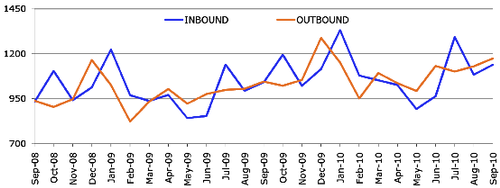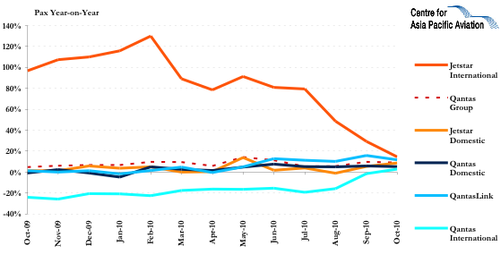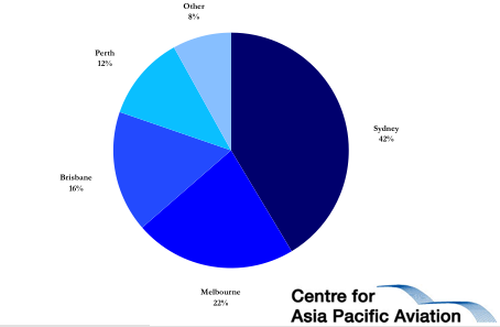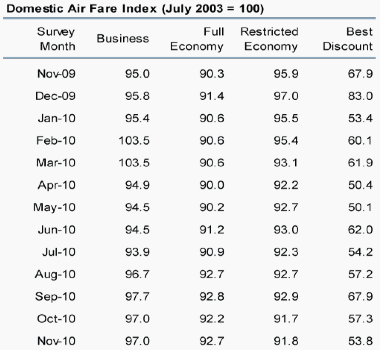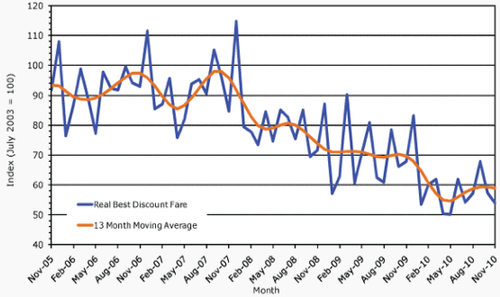International traffic to/from Australia on the rise
Australia's international traffic is on the rise with the Bureau of Infrastructure, Transport and Regional Economics (BITRE) reporting a 10.8% year-on-year improvement in international passenger numbers for Sep-2010, to 2.3 million. This follows strong month-on-month growth rates of more than 9% recorded since Sep-2009, except for Apr-2010 and May-2010 where the growth rate was more moderate.
The rise for Sep-2010 came on a 7.3% rise in flights to 12,097. Fifty-two international scheduled airlines operated services to/from Australia during the month, including four dedicated freight airlines but excluding airlines operating only via codeshare arrangements.
International passenger numbers (thousands): Sep-2008 to Sep-2010
Total seats made available on international scheduled operations to/from Australia during Sep-2010 were 2.9 million, an increase of 8.4%. Overall load factor has increased from 77.6% in Sep-2009 to 79.3% in Sep-2010. For Qantas flights to/from Australia the average load factor for the month was 82.3%. For the same period, Jetstar achieved 80.0%, Pacific Blue 73.3% and V Australia 87.0%.
Qantas maintains majority share of market, but its share is slipping
Qantas remained the largest international carrier by market share, with a 19.2% share. However, this was a decline of 1.0 ppts year-on-year. Combined with Jetstar, which has been increasing its market share over the past 12 months, the group has a market share of 27.4%. This remains a decline from Sep-2009, when the group had a market share of 28.7%. Singapore Airlines (9.0%), Emirates (8.7%) and Air New Zealand (8.0%) rounded out the top international carriers by market share for the month.
International airline market share in Australia: Sep-2010
|
Airline |
Market Share |
Growth |
|---|---|---|
|
19.2% |
-1.0 ppts |
|
|
9.0% |
-1.1 ppts |
|
|
8.7% |
+1.2 ppts |
|
|
8.2% |
-0.3 ppts |
|
|
8.0% |
Stable |
|
|
6.0% |
-0.2 ppts |
|
|
4.9% |
-0.2 ppts |
|
|
3.9% |
+0.2 ppts |
|
|
3.1% |
+1.0 ppts |
|
|
3.1% |
+0.9 ppts |
For Sep-2010, Qantas' international passenger numbers were up 3.7%, 505,000, while Jetstar reported a 3.2% rise in international passenger numbers to 339,000. However, load factor for Qantas' international services was down 1.3 ppts to 84.7%. Jetstar's international load factor was up 0.7 ppts to 80.5%.
The results were similar in Qantas' most recent data, with the carrier reporting a 1.0% year-on-year rise in international passenger numbers for Oct-2010 to 526,000. However, international load factor was down 1.2 ppts for the month to 83.4%. Jetstar reported a 4.4% rise in international passenger numbers to 353,000, with load factor up 1.1 ppts to 77.7%.
Total international yield excluding foreign exchange for the 12 months to Oct-2010 was up 14.2% year-on-year.
Qantas Group passenger number growth (% change year-on-year): Oct-2009 to Oct-2010
Domestically, Qantas' passenger numbers for Oct-2010 were up 5.2% to 1.6 million, while QantasLink also reported an increase in traffic, up 17.9% to 446,000. For Jetstar's domestic operations, passenger numbers rose 13.2% to 848,000. Domestic yields for the group were up 0.6%.
Australian carriers and LCCs gaining market share
The share of passenger traffic accounted for by Australian designated airlines rose 0.6 ppts for the period, to 33.9%. The Qantas Group, Pacific Blue (3.8% - excludes services operated under New Zealand designation), Strategic Airlines (0.2%) and V Australia (2.6%) contributed to the Australian airline share in Sep-2010.
LCCs share of the market is also growing, with AirAsia X, Indonesia AirAsia, Jetstar, Pacific Blue, Polynesian Blue and Tiger Airways accounting for 19.2% of total international passenger traffic to/from Australia in Sep-2010, up 1.0 ppts.
Traffic on top 10 routes continues to grow
Traffic on the top 10 city pairs grew by 8.7% and accounted for 34.4% of all traffic to/from Australia. Of the top 10 city pairs, the strongest growth occurred on the Denpasar-Perth route, followed by Los Angeles-Sydney, Auckland-Sydney and Singapore-Melbourne. The worst performing route in the top 10 was Auckland-Brisbane, followed by Singapore-Perth and Singapore-Brisbane.
Top 10 International route pairs to/from Australia
|
Foreign Port |
Australian Port |
Year ended Sep-2008 |
Year ended Sep-2009 |
Year ended Sep-2010 |
% of total |
% change (year-on-year) |
|---|---|---|---|---|---|---|
|
1,229,153 |
1,279,305 |
1,401,405 |
5.3% |
9.5% |
||
|
1,051,412 |
1,047,560 |
1,092,801 |
4.2% |
4.3% |
||
|
899,258 |
927,111 |
939,016 |
3.6% |
1.3% |
||
|
848,835 |
852,835 |
930,008 |
3.5% |
9.0% |
||
|
956,822 |
933,398 |
917,225 |
3.5% |
-1.7% |
||
|
Los Angeles |
546,809 |
637,352 |
887,218 |
3.4% |
39.2% |
|
|
697,213 |
762,063 |
768,292 |
2.9% |
0.8% |
||
|
825,181 |
807,107 |
709,210 |
2.7% |
-12.1% |
||
|
Denpasar |
254,253 |
378,532 |
699,486 |
2.7% |
84.8% |
|
|
725,732 |
697,883 |
699,337 |
2.7% |
0.2% |
||
|
Top 10 City Pairs |
8,034,668 |
8,323,146 |
9,043,998 |
34.4% |
8.7% |
|
|
Other City Pairs |
15 399 385 |
15 464 522 |
17,278,523 |
65.6% |
11.7% |
|
|
All City Pairs |
23 434 053 |
23 787 668 |
26,322,521 |
100.0% |
10.7% |
Sydney remains the dominant international gateway with 43.0% of all international passengers for the 12 months ended Sept-2010, followed by Melbourne, Brisbane, Perth and Gold Coast. Passenger numbers for the year ending Sep-2010 grew by 37.4% at Gold Coast, 15.6% at Perth, 14.7% at Melbourne, 9.0% at Sydney and 4.0% at Brisbane.
Australian international airport capacity share: 12 months ended Sep-2010
Freight traffic expanding
International scheduled freight traffic increased by 15.1% to 68 800 tonnes. Inbound freight traffic continues to recover with an increase of 25.0% year-on-year and 16.0% compared with Sep-2008. Inbound freight volumes are now exceeding the levels recorded during the pre-GFC peak. Outbound freight traffic increased by 1.1% year-on-year.
International traffic growth unlikely to slow in near future
The growth in international traffic is unlikely to slow, as a number of carriers are set to launch new routes or increase frequencies to/from the country over coming months, particularly for summer 2010-11.
International route changes to/from Australia
|
Airline |
Origin |
Destination |
Frequency |
Date effective |
Aircraft |
|
|---|---|---|---|---|---|---|
|
New |
Total |
|||||
|
Auckland-Santiago |
1 |
7 |
07-Nov-10 |
n/a |
||
|
4 |
28 |
15-Nov-10 |
n/a |
|||
|
3 |
10 |
16-Nov-10 |
n/a |
|||
|
1 |
11 |
21-Nov-10 |
n/a |
|||
|
1 |
7 |
21-Nov-10 |
n/a |
|||
|
2 |
2 |
02-Dec-10 |
n/a |
|||
|
Townsville-Denpasar |
2 |
2 |
03-Dec-10 |
|||
|
1 |
4 |
05-Dec-10 |
n/a |
|||
|
Bali |
4 |
11 |
16-Dec-10 |
n/a |
||
|
2 |
2 |
16-Dec-10 |
||||
|
7 |
7 |
16-Dec-10 |
A330-200 |
|||
|
Johannesburg |
1 |
3 |
16-Dec-10 |
n/a |
||
|
2 |
2 |
17-Dec-10 |
||||
|
Jakarta |
4 |
7 |
20-Dec-10 |
A330-200 |
||
|
Denpasar |
7 |
7 |
23-Dec-10 |
n/a |
||
|
3 |
3 |
02-Jan-11 |
A330-300 |
|||
|
3 |
3 |
15-Jan-11 |
n/a |
|||
|
3 |
3 |
09-Feb-11 |
||||
|
3 |
3 |
24-Feb-11 |
B777-300ER |
|||
|
6 |
10 |
27-Mar-11 |
B777-200 |
|||
|
3 |
7 |
06-Apr-11 |
n/a |
|||
|
7 |
21 |
02-Oct-11 |
B777-200ER |
|||
Discount domestic fares down ahead of Christmas
In comparison, domestic passenger numbers (including regional operations) were up 8.0% for the same month to 4.7 million. For the 12 months ended Sep-2010, domestic passenger numbers are up 4.9% to 52.8 million.
More recently, Australia's business and full-economy domestic fares were up year-on-year for Nov-2010, while restricted economy and best discount fares were down for the month.
Australian domestic fare index (July 2003 = 100): Nov-2009 to Nov-2010
Best discount fares in particular have fallen, presumably ahead of an increase again in Dec-2010 for the Christmas holidays.
Australian domestic best discount fare index (July 2003 = 100): Nov-2005 to Nov-2010
